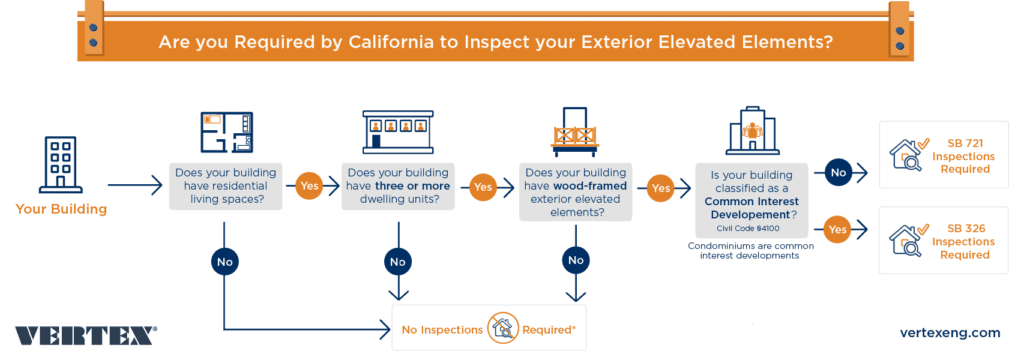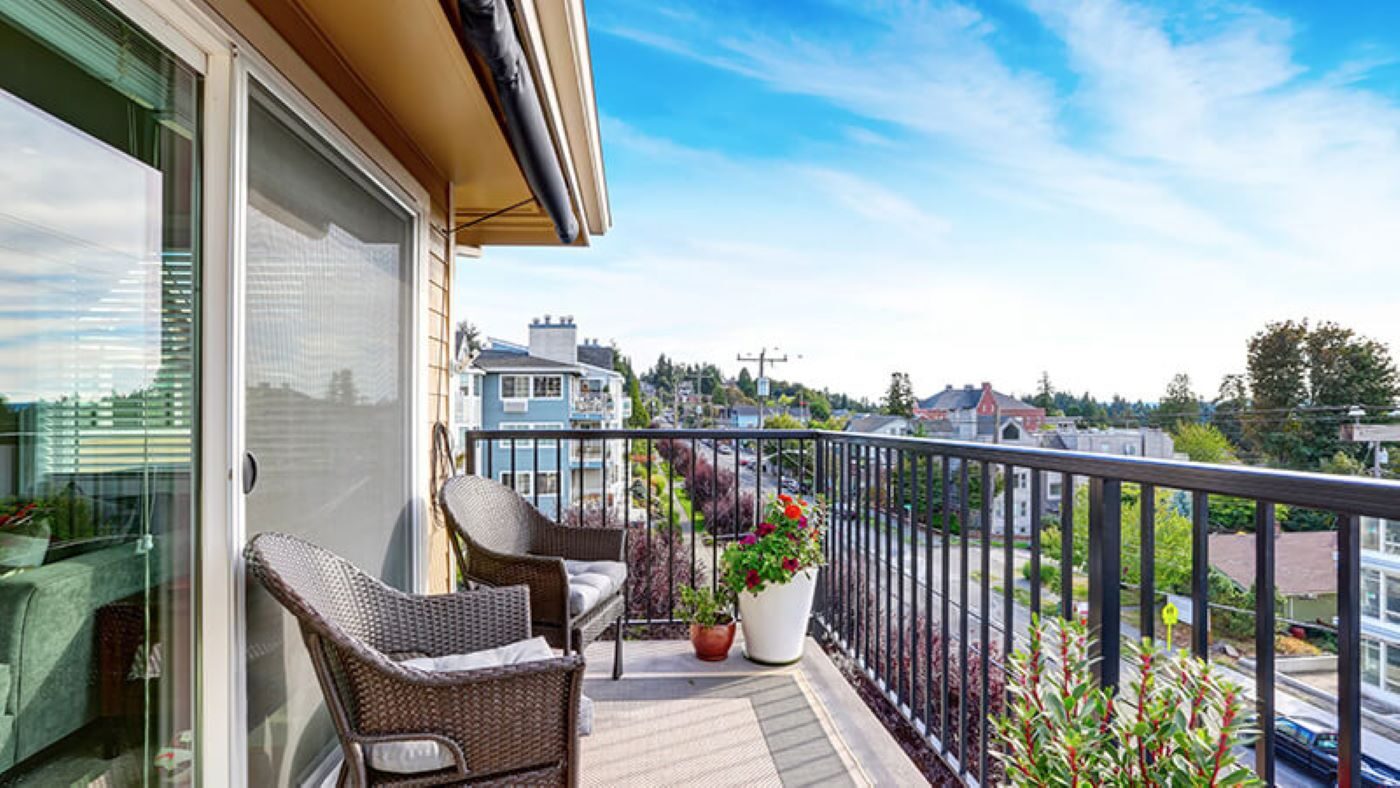“You may tear apart the baby’s rattle and see what makes the noise inside, but there is a veil covering the unseen world which not the strongest man, nor even the united strength of all the strongest men that ever lived, could tear apart.”
From “Is There a Santa Claus?” by Francis Parcellus Church.
Recently one of VERTEX’s longtime clients, an owner of a sizable portfolio of real estate that includes a variety of asset classes, asked us an intriguing question:
Do California’s Residential Care Facilities for the Elderly, and other types of senior housing need to comply with SB-721?
As you may recall, California Senate Bill No. 721, passed into law under the Health and Safety Code under section 17973 in 2019, requires that owners of multi-family residential properties meeting certain criteria have their Exterior Elevated Elements (EEEs) inspected by January 1, 2025. Many people refer to it as the balcony inspection law.
To answer the client’s question, we reached out to two of VERTEX’s leading forensic architects licensed in the state California: Matt Click, and Kirk O’Brien.
What RCFE(s) need to comply with SB-721?
According to Matt and Kirk, the criteria spelled out in SB-721 applies to “…all buildings containing three or multifamily dwelling units…,” however, “[t]his section shall not apply to a common interest development, as defined in Section 4100 of the Civil Code.” That means that SB-721 applies to any multifamily residential building that is not a condominium. Condo buildings are covered by a similar balcony inspection law, SB-326.
Therefore, if a Residential Care Facility for the Elderly (RCFE) or other type of senior care facility is a multifamily residential building. Unless it happens to also be condominium, SB-721 inspection requirements would apply.

What is the SB-721 compliance process like at senior care facilities?
Much like at any other multifamily building subject to the balcony inspection law, we have found working with our clients that the following three-step process is most effective:
- Pre-Inspection Site Survey: The first and most important step on the path to SB-721 compliance is to establish what elements at a property are subject to the law, and what will the minimum requirements be to meet the inspection requirements outlined in the law. Besides balconies, SB-721 requires that a 15% sampling of ALL exterior elevated elements (“EEEs”) be inspected. That means that elevated walkways, stair assemblies, landings and other types of assemblies will need to be considered as part of the compliance process. The Pre-Inspection Site Survey is also an important opportunity for an SB-721 inspection service provider, such as VERTEX’s Balcony Assurance team, to meet with facility staff to understand safety and security protocols that would apply to the inspection process.
- Screening Inspections: This of course is the main event, so to speak. With the careful planning following the information collected from the Pre-Inspection Site Survey, the objective for the screening inspections is to collect as much information as possible, in a short amount of time, so as to minimize the impact on residents and staff. Using highly trained professionals with sophisticated and specialized diagnostic tools, the VERTEX Balcony Assurance team is able to inspect dozens of EEEs per day, leaving no trace of our presence following the inspection.
- Analysis & Reporting: All that data collected during the inspections needs to be carefully reviewed and analyzed. For the VERTEX Balcony Assurance team, our field data is captured using highly secure, cloud-based services custom-tailored to meet the reporting needs of SB-721. Findings regarding the condition and estimated service life of each and every EEE inspected are collected in proprietary checklists. The checklists and the many supporting photos are analyzed by experienced construction forensic experts. Any recommendations for repair or further inspection are included in the report, along with an extensive appendix that includes all data collected at the site.
What is the timeline for SB-721 compliance?
As with most things involving the built environment, time is of the essence. Time is really running out as the deadline for completing the first inspection is January 1, 2025.
That’s just the first round. The balcony inspection law requires that properties have EEE inspections every 6 years. If you are only responsible for compliance for one property, that doesn’t seem so difficult. For owners and managers of multiple apartment properties we recommend establishing a program so that you can plan out the inspection/reporting/repair of the portfolio over the course of the 6-year period.
In addition, the law allows for cities to establish their own more restrictive requirements and the cities of San Francisco and Berkeley have done just that. Section 604 and Section 604.1, respectively, require more frequent inspections than SB-721 and apply to a wider range of element types.
Getting inspections done on time is important but there is another critical timeline: when repairs need to be made. One of the most stringent requirements introduced by SB-721, in our opinion, is that when an inspector delivers a report to an owner that recommends repairs, the owner has just 120 days to obtain repair permits, and a further 120 days to implement the repairs. Unless the owner has something in writing from the local jurisdiction waiving those requirements, the owner could be subject to daily fines.
Another critical timing factor is triggered if/when potential life-safety threats are discovered during the inspection process. The law states the following:
An exterior elevated element that the inspector advises poses an immediate threat to the safety of the occupants, or finds preventing occupant access or emergency repairs, including shoring, or both, are necessary, shall be considered an emergency condition and the owner of the building shall perform required preventive measures immediately. Immediately preventing occupant access to the exterior elevated element until emergency repairs can be completed constitutes compliance with this paragraph. Repairs of emergency conditions shall comply with the requirements of subdivision (g), be inspected by the inspector, and reported to the local enforcement agency.
While there are some ways to mitigate the impact that some of the SB-721 timing requirements have on owners, they remain a factor to be considered nonetheless.
What’s the Point?
California Health and Safety Code Section 17973, is not one of the more “frivolous” laws passed in the state known for passing some of the most restrictive laws in the nation. Rather, this law came about after lawmakers heard testimony from Ms. Aoife Beary, whose 21st birthday was being celebrated when the balcony collapsed in Berkeley, leaving several of her friends dead, and her with severe injuries that would ultimately take her life as well just a few months ago. This tragic loss of life occurred at a relatively newly constructed and certainly well-maintained building.
The collapse could arguably have been prevented had the owners of the facility been aware of the advanced deterioration of the concealed wood framing members.
The laws that govern senior care facilities including Residential Care Facilities for the Elderly, were also put into place to ensure that safety of residents of certain buildings. The regulations require facilities to be maintained to state standards such as California Code of Regulations Title 22, § 87303(a).
We believe following SB 721 is an essential part of maintaining the facility’s safety and ensuring it is in good repair. Therefore, the sooner that managers get EEEs inspected, the sooner that any unforeseen risks can be discovered and managed.
In addition, here are some other considerations that apply to multifamily residential properties in general, but should definitely be taken to heart when it comes to senior care:
- 15% is typically not a large enough sample size to be considered “statistically significant,” so we recommend either exceeding this minimum sample size requirement or supplementing the more invasive inspection on the sample and visual inspection on the other EEEs at the property. If you pursue the second option, you can correlate the findings of both inspection types and yield more reliable data.
- Consider the option of installing soffit vents below EEEs as part of the inspection process. Not only does it provide a better quality of inspection data, it will make future inspections easier and can extend the useful life of the assemblies.
- Armed with the knowledge that will come from understanding the true condition of the EEEs at a given property, along with updating the maintenance program and repairing any conditions where warranted, will result in buildings that are safer for residents, but with less surprises down the road when it comes to major repairs.
What’s Next?
For owner’s and managers of multifamily senior care facilities, it’s important to get your EEE inspection scheduled sooner rather than later. Soon the deadline will no longer be counted in years, but instead months, and eventually in days. Given that there are millions of multifamily units in California and not many inspectors, we expect industry will experience a rush to schedule EEE inspections in the months leading up to 2025.
To save yourself the stress of not finding a qualified inspector in time, contact us on our Balcony Assurance page or call 858.436.7770.
Author: Brian Hill



